

A Guide to Recovery, Healing, and Wellness Naomi Aaronson, MA, OTR/L, CHT, CPI, CET Ann Marie Turo, OTR/L
 Visit our website at www.demoshealth.comISBN:
Visit our website at www.demoshealth.comISBN: 978-1-936303-57-1
e-book ISBN: 978-1-617051-95-1
Acquisitions Editor: Julia Pastore
Compositor: diacriTech 2014 by Naomi Aaronson and Ann Marie Turo. All rights reserved. This book is protected by copyright. No part of it may be reproduced, stored in a retrieval system, or transmitted in any form or by any means, electronic, mechanical, photocopying, recording, or otherwise, without the prior written permission of the publisher. Medical information provided by Demos Health, in the absence of a visit with a health care professional, must be considered as an educational service only. This book is not designed to replace a physicians independent judgment about the appropriateness or risks of a procedure or therapy for a given patient.
Our purpose is to provide you with information that will help you make your own health care decisions. The information and opinions provided here are believed to be accurate and sound, based on the best judgment available to the authors, editors, and publisher, but readers who fail to consult appropriate health authorities assume the risk of injuries. The publisher is not responsible for errors or omissions. The editors and publisher welcome any reader to report to the publisher any discrepancies or inaccuracies noticed. Library of Congress Cataloging-in-Publication Data Aaronson, Naomi, author. p. ; cm. ; cm.
Includes bibliographical references and index. ISBN 978-1-936303-57-1ISBN 978-1-61705-195-1 (e-book) I. Turo, Ann Marie, author. II. Title. [DNLM: 1.
Breast NeoplasmsrehabilitationPopular Works. 2. Breathing ExercisesPopular Works. 3. Exercise Movement TechniquesPopular Works. 4.
Relaxation TherapyPopular Works. WP 870] RC271.Y63 616.9944906dc23 2014020932
Special discounts on bulk quantities of Demos Health books are available to corporations, professional associations, pharmaceutical companies, health care organizations, and other qualifying groups. For details, please contact: Special Sales Department Demos Medical Publishing, LLC 11 West 42nd Street, 15th Floor New York, NY 10036 Phone: 800-532-8663 or 212-683-0072 Fax: 212-941-7842 E-mail:
Printed in the United States of America by Bang Printing. 14 15 16 17 18 / 5 4 3 2 1
This book is dedicated to Beth Mast, an occupational therapist and Pilates practitioner who has used Pilates to recover from breast cancer and who is now using Pilates on her journey through living with metastatic cancer. Beth says that, Pilates can be done by even the weakest. It was the only exercise that she could tolerate after going through chemotherapy and becoming increasingly anemic, unable to stand even to brush her teeth. Learning to live with cancer is an art, not a science.
Each person must find her own way, in her own style. What is important to realize is that a way can be found regardless of the circumstances and prospects. Jane E. Brody
Contents
: Ann Maries Journey through Breast Cancer












Preface
Ann Maries Journey through Breast Cancer
I was always a person who exercised, took a whole arsenal of vitamins, read everything on health and fitness, and ate correctly. As an occupational therapist, I prided myself on being up on my health and well-being. So when I got the diagnosis of breast cancer, I was in shock.
How could this be? But in January of 1991, my doctor found a tiny lump the size of a pea in my left breast. My breast cancer journey began. My mind was telling me: They read the wrong pathology report: DENIAL. I took care of myself how could this be: ANGER. If I could just have my health back, Ill never stand in front of the microwave again and will only eat organic foods: BARGAINING. There were days I couldnt dress myself, or days that I would put the same clothing on that I had dumped on the chair the night before: DEPRESSION. These stages should sound familiar to every person who has been diagnosed with a life threatening illness or disease. Many people will go through at least one or all of the Kbler-Ross stages of grief. I was lucky. I received a lumpectomy/partial mastectomy and clean margins were reached.
In 2001, eleven years after my first diagnosis, breast cancer came knocking at my door again in the left breast. At that moment, I felt a sense of acceptance as I knew what I needed to do, but immediately, I moved again into the denial stage. I told my doctor that I was here today for my yearly mammogram and not for surgery. The cycle of anger, bargaining, and depression repeated itself. When you are diagnosed with a disease such as cancer, your life changes from that moment on. You begin to think about your future, and whether you will be here one year from now.
You also think about what is important to you and your family, and what life really means to you. You make decisions based on the information that is available to you. You think about what you are willing to endure. The what ifs and the if nots play around in your head. But each of us is different and will make different treatment decisions. I made mine based on what I felt would provide me the best chance of survival and quality of life.
In 2002, three months after another partial mastectomy, I decided to enroll in Pilates reformer training (a reformer is a piece of resistance exercise equipment designed by Joseph Pilates). I had been trained in mat Pilates in 2001, but felt this was a natural next step. I got the OK from my surgeon and moved forward. When I look back on it today, it wasnt the best decision. I was not completely healed, had poor endurance, left shoulder tightness, and my scapula was nowhere to be found! My proprioception (awareness of my own body in space) and kinesthetic awareness (my ability to sense movement) was so poor that I had no clue where my left arm was or what it was doing. The training was tough, but I kept on telling myself, If I got through breast cancer, I could get through anything.
I dont recommend that you start with reformer training, but Pilates is an excellent way to heal. Pilates was the best thing for me then. It helped me regain my strength and the confidence to navigate the world after undergoing life changing surgery and treatment. The deep breathing along with the specific Pilates exercises in this book helped me to focus and relax, as well as stretch my tight chest, side, and back muscles. Finally, Pilates offered me the opportunity to regain control over a body that had betrayed me as well as providing a safe and nurturing space to relax and focus on healing and recovery. That saying, Its the journey not the destination, is so true.

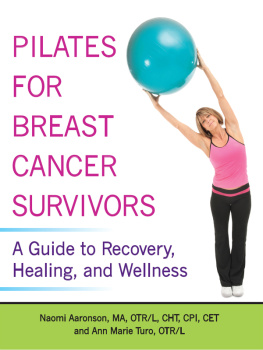
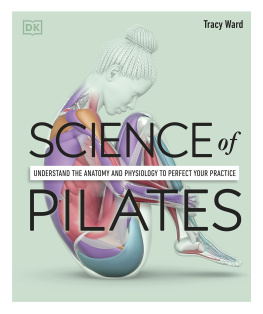

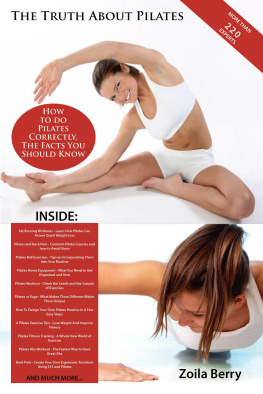

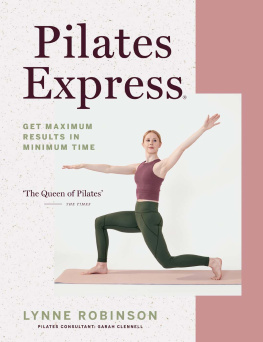
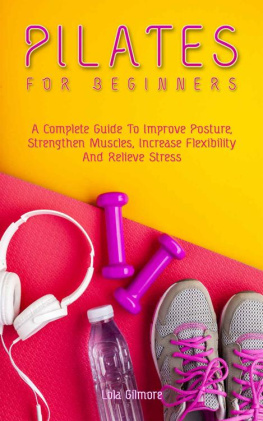



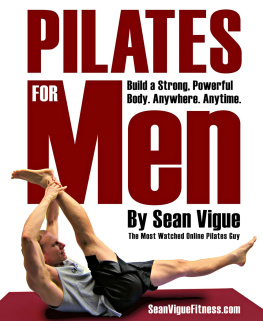
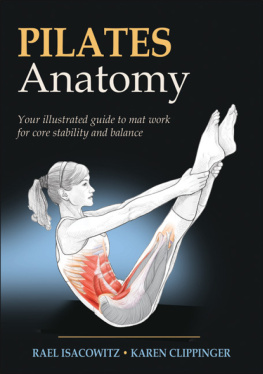
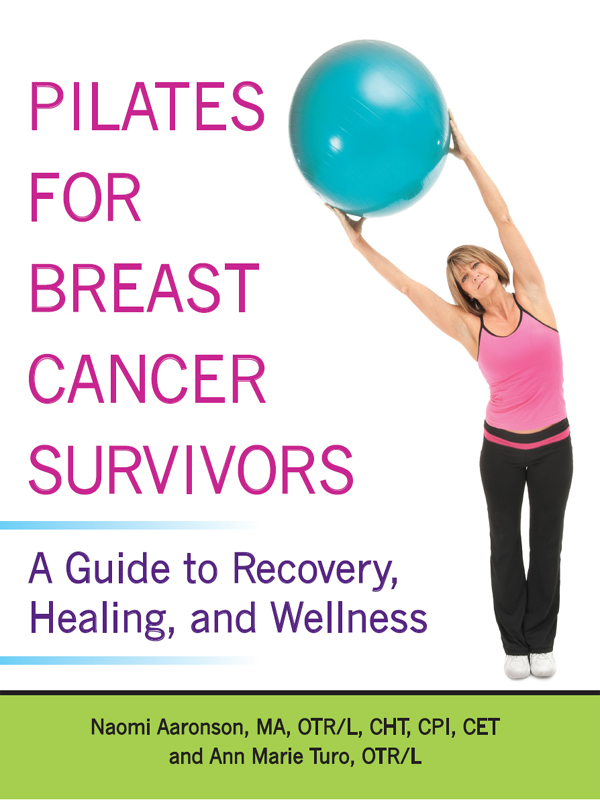

 A Guide to Recovery, Healing, and Wellness Naomi Aaronson, MA, OTR/L, CHT, CPI, CET Ann Marie Turo, OTR/L
A Guide to Recovery, Healing, and Wellness Naomi Aaronson, MA, OTR/L, CHT, CPI, CET Ann Marie Turo, OTR/L  Visit our website at www.demoshealth.comISBN: 978-1-936303-57-1 e-book ISBN: 978-1-617051-95-1 Acquisitions Editor: Julia Pastore Compositor: diacriTech 2014 by Naomi Aaronson and Ann Marie Turo. All rights reserved. This book is protected by copyright. No part of it may be reproduced, stored in a retrieval system, or transmitted in any form or by any means, electronic, mechanical, photocopying, recording, or otherwise, without the prior written permission of the publisher. Medical information provided by Demos Health, in the absence of a visit with a health care professional, must be considered as an educational service only. This book is not designed to replace a physicians independent judgment about the appropriateness or risks of a procedure or therapy for a given patient.
Visit our website at www.demoshealth.comISBN: 978-1-936303-57-1 e-book ISBN: 978-1-617051-95-1 Acquisitions Editor: Julia Pastore Compositor: diacriTech 2014 by Naomi Aaronson and Ann Marie Turo. All rights reserved. This book is protected by copyright. No part of it may be reproduced, stored in a retrieval system, or transmitted in any form or by any means, electronic, mechanical, photocopying, recording, or otherwise, without the prior written permission of the publisher. Medical information provided by Demos Health, in the absence of a visit with a health care professional, must be considered as an educational service only. This book is not designed to replace a physicians independent judgment about the appropriateness or risks of a procedure or therapy for a given patient. 

